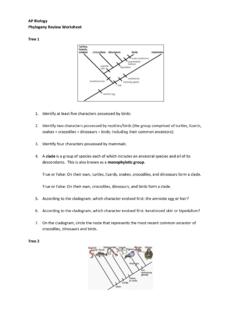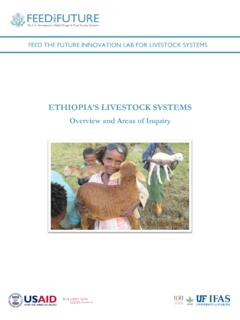Transcription of AP Genetics Worksheet - Nauset Public Schools
1 AP Biology Genetics Review Worksheet Monohybrid Cross Questions 1. White coloring in guinea pigs is recessive. What will the offspring be from a cross between a white guinea pig and a heterozygous black guinea pig? 2. Free ear lobes are dominant over attached ear lobes. What will the F1 offspring be from a cross between two heterozygous free ear lobed parents? 3. The ability to taste phenythiocarbamide (PTC) is dependent upon a dominant gene, T. The recessive allele, t, is associated with the inability to taste the substance. (a) What are the possible genotypes for tasters? For non-tasters? (b) Two parents, both tasters, have a non-taster offspring.
2 What are the genotypes of the two parents? Explain. (c) Two parents, one a taster and the other a non-taster, have a taster offspring. What is the genotype of the offspring? Explain. 4. In Drosophila (fruit flies), curly wings are recessive to its normal allele for straight wings. A homozygous curly wing male is mated with a homozygous straight winged female. What would be the genotype and phenotype of the F1? 5. In the alien race of Pzkrauks, hairy tongue is a recessive trait to the normal hairless tongue. If a male who is heterozygous normal tongue has children with a homozygous normal tongue female, what would be the genotypes and phenotypes of their offspring?
3 What percentage would be hairy tongued? What percentage would be normal tongued? Codominance and Incomplete Dominance 1. When shorthorn red cattle are bred to shorthorn white cattle, they produce roan (red and white hairs interspersed) offspring. What type of inheritance is this? (a) If two roan shorthorns are crossed, what is the probability of red, white and roan colors in their offspring? 2. In the petunia, a pure breeding red flower is crossed with a white one to produce pink offspring. What form of inheritance is this? (a) Show the genotypes of the parents and the F1 generation of a cross between a red and white petunia.
4 (b) What would be the anticipated offspring if the F1 plant from (a) above were test-crossed to the red parent? (c) What would be the anticipated offspring if the F1 plant from (a) above were test-crossed to the white parent? 3. In Andalusian fowl, FB is the gene for black plumage. Fb is the gene for white plumage. These genes show incomplete dominance. The heterozygous condition results in blue plumage. List the genotypic and phenotypic ratios expected from the crosses: (a) black X blue (b) blue X blue (c) blue X white 4. Two carnations (flowers), a red one and a white one, are crossed and the F2 offspring have three different genotypes.
5 If this gene shows incomplete dominance, what is the color of the heterozygous plants? 5. In guinea pigs, coat color is determined by at least three alleles. Yellow is homozygous dominant, two other colors are also possible; white and ecru (cream-colored). Which is the homozygous recessive color? Determine the expected genotype and phenotype ratio of the F1 generation which would result from: (a) a cross between two cream-colored guinea pigs (b) a yellow-coated and cream-coated animal breeding 6. On a fox ranch, a mutation arose that gave a platinum coat color that was very popular with fur buyers. The breeders couldn t breed a pure strain of platinum foxes; every time they bred two platinum foxes together, there were some normal foxes in the progeny.
6 For example, in repeated matings of the same platinum foxes, 82 platinum foxes and 38 normal offspring were produced. State a concise genetic hypothesis to account for these results. 7. In dogs, gum coloration is co-dominant, with black exerting dominance over pink. You have a lovely spotted gummed Labrador retriever who has just had 8 pups. Four of the pups have spotted gums like your dog, and 4 have pink gums. What is the likely phenotype of the sneaky neighbor dog? Blood Types and Multiple Alleles 1. In a maternity ward, four babies become accidentally mixed up. The ABO blood types of the four babies are known to be: Baby Jane is O, Baby John is A, Baby Christopher is B, and Baby Robin is AB.
7 The ABO types of the four sets of parents are determined as such: The Andersons are AB and O, the Browns are A and O, the Christianson s are A and AB, and the Dietrich s are O and O. Indicate which baby belongs to each set of parents. Numerical Response (Grid In) 1. The probability that a mother with blood type O and a father with genotype IBi would have a child with blood type O is _____. (Record your answer as a value from 0 to 1, rounded to two decimal places, in the numerical-response section on the answer sheet.) 2. In corn, pure lines are obtained that have either sun red, pink, scarlet, or orange kernels when exposed to sunlight.
8 The following table gives the results of some of these crosses between lines. Analyze the results of each cross, and provide a dominance hierarchy for kernel color in corn. Cross Parental phenotypes F1 phenotypes F2 phenotypes 1 sun red X pink all sun red 66 sun red : 20 pink 2 orange X sun red all sun red 998 sun red : 314 orange 3 orange X pink all orange 1300 orange : 429 pink 4 scarlet X orange all yellow 182 yellow : 80 orange : 58 scarlet 3. Multiple alleles control the coat color of rabbits. A grey color is produced by the dominant allele C. The Cch allele produces a silver grey color when present in the homozygous condition called chinchilla.
9 When Cch is present with a recessive gene, a light silver grey color is produced. The allele Ch produces a white color with black extremities called Himalayan. An allele Ca is recessive to all genes and results in the albino (non-pigmented condition). The dominance hierarchy is: C > Cch > Ch > Ca. The following table shows the genotypes and phenotypes for rabbit coats: Phenotypes Genotypes Full color CC, CCch, CCh, CCa Chinchilla CchCch Light grey CchCh, CchCa Himalayan ChCh, ChCa Albino CaCa (a) Indicate the genotypes and phenotypes of the F1 generation from the mating of a heterozygous Himalayan coat rabbit with an albino coat rabbit.
10 (b) The mating of a full color rabbit with a light grey rabbit produces two full color offspring, one light grey offspring, and one albino offspring. Indicate the genotypes of the parents. Numerical Response (Grid In) 2. The probability that a father with genotype ii and a mother with blood type AB would have a son with blood type B is _____. (Record your answer as a whole number in the numerical-response section of the answer sheet.) Dihybrid Cross Questions 1. What would be the expected phenotypic ratio of the F1 offspring if a heterozygous, tall round pea plant pollinated itself? Tall is dominant to short, and round is dominant to wrinkled in pea plants.








